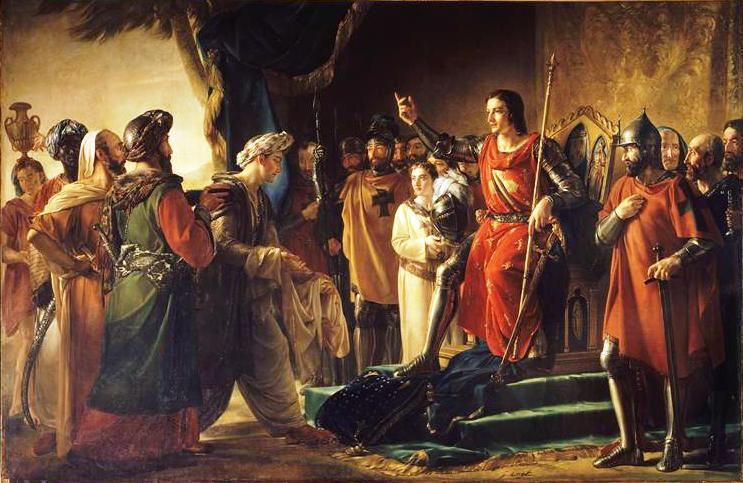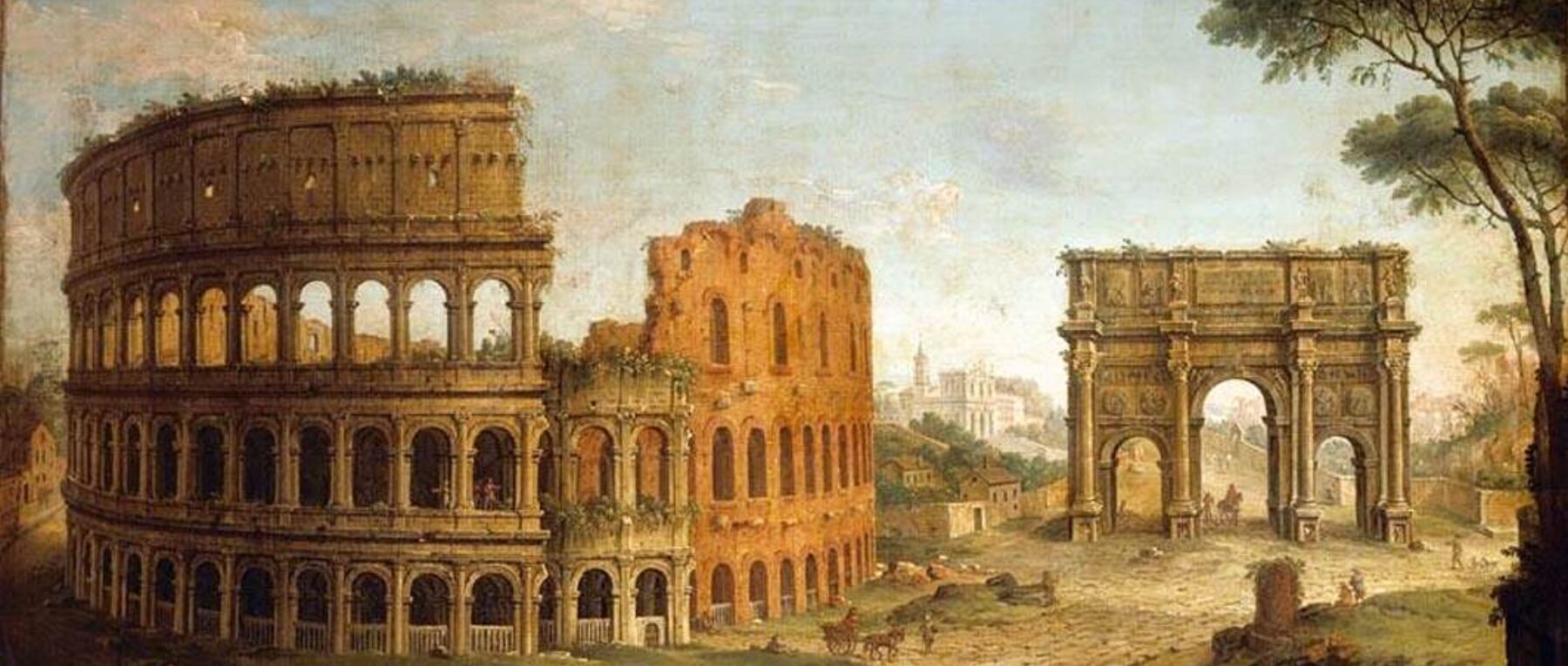
When King Louis IX encountered the Real Assassin’s Creed and the Old Man of the Mountain
In May 1250, in the city of Acre, envoys of the Order of Assassins arrived to see the French King Louis IX. They were sent by their mysterious leader, ‘The Old Man of the Mountain’ with gifts of defiance if his demands were not met. Jean of Joinville, who was present, describes in vivid detail the encounter and the ominous gifts presented to the king in his The Life of St Louis.
“In his clenched fist he held three knives, with blades that each fitted into the handle of another, these, if the emir’s proposals were rejected, he was to present to the king in token of defiance. Behind this young man was another, who had a stout roll of linen would round his arm, which he was to present to the king as a winding-sheet for his burial if he refused the Old Man of the Mountain’s demands.” (Jean of Joinville, The Life of St Louis, p.277)
The Assassins and The Old Man of The Mountain
 |
| 19th Century imaginary engraving of the ‘Old Man of the Mountain’, as Hassan Ibn Sabbah was referred (Source: Wikimedia) |
The mysterious figure known as the ‘Old Man of the Mountain’ was the leader of a sect known as the Nazari Isma’ili. This enigmatic name was first used by Marco Polo in his work the Book of the Marvels of the World, to refer to the founder of the sect, Hassan Ibn Sabbah (1050-1124), whose headquarters were in the fortress of Alamut, Persia.
Later it was used by Crusader and western sources to refer to the leaders of the sect in general, and particularly, Rashid al din Sinan, the leader of the Syrian branch of the sect. In the 12th century a number of mountain fortresses in Syria were occupied by the sect, such as Masyaf, which were used as a base of operations in Syria and the surrounding regions.
 |
| Masyaf Castle Syria (Source: Wikimedia) |
The Nazari Isma’ili sect became known to both Crusader and other Muslim sources as the infamous Assassins. The name is thought to be a corruption of the Arabic Hashishi, which denoted someone who smoked hash or Indian hemp. The term of course became the basis for our modern english word ‘assassin‘, referring to someone who kills for political or idealogical reasons.
According to Marco Polo and other Muslim sources, Assassin initiates were believed to consume the drug so as to have ecstatic visions of paradise which gave them the assurance of their reward after the successful completion of their mission. There is however no evidence for this and it is now thought it was used mainly in Arabic as a derogatory word meaning, someone who is ‘lazy’ or uncouth.
The Demands of the Envoys and Medieval Realpolitik
 |
| The Hospitaller Fortress in Acre (Source: The Complete Pilgrim) |
 |
| The Courtyard at the Hospitaller Commandery where the meeting likely took place. (Source: Wikimedia) |
At the headquarters of the Knights Hospitaller, both of the Marshal’s spoke to the envoy (through an interpreter) and sternly reprimanded his Master for his “insolent message” and in visiting the king and making such demands upon his majesty.
Joinville recounts that the Marshals told the envoy further, that were not the honour of the king involved “they would have had them drowned in the filthy sea of Acre, in despite of the Old Man of the Mountain.”
The envoys were commanded to return to the ‘Old Man of the Mountain’ and in two weeks return again with a letter and gifts befitting his majesty.
Gifts Given and Gifts Received
Upon their return, the envoys brought a letter and many gifts for the king. One of these was the personal shirt of the ‘Old Man’, that signified the close bond now shared between the two leaders.
Another was the gold ring of the ‘Old Man’ which was engraved with the king’s name and symbolised their close alliance. Further to this were given many exquisite gifts including the figure of an elephant, a giraffe, apples made of crystals, along with gaming boards and chessman.
Concerning these objects Joinville recounts:
“All of these objects were profusely decorated with little flowers made if amber, which were attached to the crystal by means of delicately fashioned clips of good fine gold. I might add that when the envoys opened the caskets containing these gifts, so sweet a scent arose from them that the whole room was filled with perfume.” (Jean of Joinville, The Life of St Louis, p.278)
A Friar reports back the beliefs of the Old Man and the Assassins
 |
| The remains of the Fortress of Alamut in Persia (Source: Wikimedia) |
The king sent the envoys back to the ‘Old Man’ with a great quantity of jewels and precious objects along with a friar called Yves Le Breton. He was learned in the ‘saracen’ language and reported back many interesting things about the Assassins and their mysterious leader.
Concerning the beliefs of the Assassins, the friar reported that one of the doctrines of Ali was particularly significant to the Assassins when carrying out a mission. That is the notion that when “a man is killed while obeying his lord’s orders his soul goes into a more pleasing body than before.” The friar explains this is the reason they are not afraid to be killed when carrying out a mission as they believe they will be in a more pleasing place.
The Friar and the ‘Old Man’ also discussed a book that was on his bedside table. The book recorded the words of the Lord spoken to St Peter while he was on earth. The ‘Old Man’ told the friar that he read it often and that St Peter was very dear to him, apparently being the reincarnation of Abel from the beginning of the World.
All these things the friar reported to king Louis.
The account ends with a threatening anecdote about the ‘Old Man of the Mountain’. According to Joinville, whenever he left his mountain redoubt, a crier would go before him brandishing a Danish axe with a silver encased shaft, to which knives were attached. As he rode forth, the crier would sound:
“Turn out of the way of him who bears in his hands the death of kings.”
Sources:
Bernard Lewis, The Ismalilities and the Assassins, chapter IV.
https://www.britannica.com/biography/Louis-IX
https://www.britannica.com/story/who-were-the-assassins
Joinville and Villehardouin, Chronicles of the Crusades, Translation by M.R.B. Shaw, Penguin Books, England, 1963, Chapt 12, p. 277
https://en.wikipedia.org/wiki/Old_Man_of_the_Mountain_(Assassin)
https://www.worldhistory.org/The_Assassins/

Thank you for writing this post!